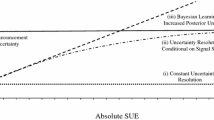Abstract
Prior research has been unable to explain the phenomenon known as post-earnings announcement drift, raising questions concerning the semi-strong form efficiency of the market typically assumed in capital market research. This study contributes to our understanding of this anomaly by examining drift in the context of theories that consider investors' non-Bayesian behaviors. The empirical evidence reveals that investors' overconfidence about their private information and the reliability of the earnings information are two important factors that explain drift. Finally, this study also provides insight into the puzzling relationship between dispersion and drift discussed in prior research.
Similar content being viewed by others
References
Abarbanell, J. and V. Bernard. (1992). “Tests of Analysts' Overreaction/Underreaction to Earnings Information as an Explanation for Anomalous Stock Price Behavior.” Journal of Finance 47, 1181- 1207.
Alford, A. and P. Berger. (1997). “The Effect of Extreme Accounting Events on Analyst Following and Forecast Accuracy.” Working Paper, University of Pennsylvania.
Ali, A. and P. Zarowin. (1992). “The Role of Earnings Levels in Annual Earnings—Returns Studies.” Journal of Accounting Research 30, 286-296.
Baber, W., S. Kang and K. Kumar. (1999). “The Explanatory Power of Earnings Levels vs. Earnings Changes in the Context of Executive Compensation.” The Accounting Review 74, 459-472.
Ball, R. and P. Brown. (1968). “An Empirical Evaluation of Accounting Income Numbers.” Journal of Accounting Research 6, 159-178
Ball, R. and E. Bartov. (1996). “How Naïve is the Stock Market's Use of Earnings Information?” Journal of Accounting and Economics 21, 319-337.
Ball, R., S. P. Kothari and R. Watts. (1993). “Economic Determinants of the Relation Between Earnings Changes and Stock Returns.” The Accounting Review 68, 622-639.
Barron, O. (1995). “Trading Volume and Belief Revisions that Differ Among Individual Analysts.” The Accounting Review 70, 581-597.
Barron, O., D. Byard and O. Kim. (2002). “Changes in Analysts' Information around Earnings Announcements.” The Accounting Review 77, 821-846.
Barron, O., O. Kim, D. Lim and D. Stevens. (1998). “Using Analysts' Forecasts to Measure Properties of Analysts' Information Environment.” The Accounting Review 73, 421-433.
Barron, O. and P. Stuerke. (1998). “Dispersion in Analysts' Earnings Forecasts as a Measure of Uncertainty.” Journal of Accounting, Auditing and Finance 13, 243-268.
Bartov, E. (1992). “Patterns in Unexpected Earnings as an Explanation for Post-Announcement Drift.” The Accounting Review 67, 610-622.
Bartov, E., S. Radhakrishnan and I. Krinsky. (2000). “Investor Sophistication and Patterns in Stock Returns after Earnings Announcements.” The Accounting Review 75, 43-63.
Belsley, D. A., E. Kuh, and R. E. Welsch. (1980). Regression Diagnostics. New York: John Wiley & Sons.
Bernard, V. and J. Thomas. (1989). “Post-Earnings-Announcement Drift: Delayed Price Response of Risk Premium?” Journal of Accounting Research 27, 1-48.
Bernard, V. and J. Thomas. (1990). “Evidence that Stock Prices Do Not Fully Reflect the Implications of Current Earnings for Future Earnings.” Journal of Accounting and Economics 13, 305-341.
Bhushan, R. (1994). “An Informational Efficiency Perspective on the Post-Earnings Announcement Drift.” Journal of Accounting and Economics 18, 45-65.
Bloomfield, R., R. Libby and M. Nelson. (2000). “Under-Reactions and Over-Reactions: The Influence of Information Reliability and Portfolio Formation Rules.” Journal of Financial Markets 3, 113-137.
Chan, L., N. Jegadeesh and J. Lakonishok. (1996). “Momentum Strategies.” Journal of Finance 51, 1681- 1713.
Christie, A. (1987). “On Cross-Sectional Analysis in Accounting Research.” Journal of Accounting and Economics 9, 231-258.
Daniel, K., D. Hirshleifer and A. Subrahmanyam. (1998). “Investor Psychology and Security Market Under-and Overreactions.” Journal of Finance 53, 1839-1885.
Diether, K., C. Malloy and A. Scherbina. (2002). “Differences of Opinion and the Cross-Section of Stock Returns.” Journal of Finance 57, 2113-2141.
Dische, A. (2001). “Dispersion in Analyst Forecasts and the Profitability of Earnings Momentum Strategies.” Working Paper, Harvard University.
Fischer, P. (2001). “Drift as an Evolutionary Outcome.” Working Paper, Penn State University.
Foster, G., C. Olsen and T. Shevlin. (1984). “Earnings Releases, Anomalies, and the Behavior of Security Returns.” The Accounting Review 59, 574-603
Freeman, R. and S. Tse. (1989). “The Multiperiod Information Content of Accounting Earnings: Confirmations and Contradictions of Previous Earnings Reports.” Journal of Accounting Research 27, 49-79
Gleason, C. and C. Lee. (2002). “Analyst Forecast Revisions and Market Price Formation.” The Accounting Review 78, 193-226.
Griffin, D. and A. Tversky. (1992). “The Weighting of Evidence and the Determinants of Confidence.” Cognitive Psychology 24, 411-435.
Hong, H. and J. Stein. (1999). “A Unified Theory of Underreaction, Momentum Trading, and Overreaction in Asset Markets.” Journal of Finance 54, 2143-2184.
Jones, C. and R. Litzenberger. (1970). “Quarterly Earnings Reports and Intermediate Stock Price Trends.” Journal of Finance 24, 143-148.
Lang, M. and R. Lundholm. (1996). “Corporate Disclosure Policy and Analyst Behavior.” The Accounting Review 71, 467-491.
Lee, C. and B. Swaminathan. (2000). “Price Momentum and Trading Volume.” Journal of Finance 55, 2017-2070.
Liu, J. (1998). “Earnings Announcements, Post-Earnings-Announcement Drift and Analysts' Forecasts: the Relationship Between the Market Reaction and Analysts' Behavior.” Working Paper, Columbia Business School.
Liu, J. and J. Thomas. (1998). “Stock Returns and Accounting Earnings.” Working Paper, Columbia Business School.
Mendenhall, R. (1991). “Evidence of Possible Underweighting of Earnings-Related Information.” Journal of Accounting Research 29, 170-180.
Raedy, J. S. (1998). “A Reconciliation of Stock Market Anomalies.” Working Paper, University of North Carolina.
Shane, P. and P. Brous. (2001). “Investor and (Value Line) Analyst Underreaction to Information about Future Earnings: the Corrective Role of Non-Earnings-Surprise Information.” Journal of Accounting Research 39, 387-404.
Schipper, K. (1991). “Commentary of Analysts' Forecasts.” Accounting Horizons 5, 105-121.
Sloan, R. (1996). “Do Stock Prices Fully Reflect Information in Accruals and Cash Flows about Future Earnings?” The Accounting Review 71, 289-316.
Soffer, L. and Thomas Lys. (1998). “Post-Earnings Announcement Drift and the Dissemination of Predictable Information.” Working Paper, Northwestern University.
Wu, J. S. (1998). “Financial Analysts' Understanding of the Seasonal Patterns in Quarterly Earnings and Its Implications for Market Efficiency.” Working Paper, University of Rochester.
Author information
Authors and Affiliations
Rights and permissions
About this article
Cite this article
Liang, L. Post-Earnings Announcement Drift and Market Participants' Information Processing Biases. Review of Accounting Studies 8, 321–345 (2003). https://doi.org/10.1023/A:1024477831740
Issue Date:
DOI: https://doi.org/10.1023/A:1024477831740




